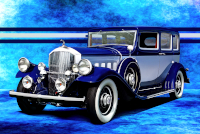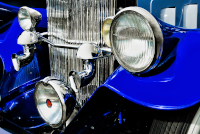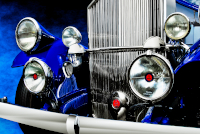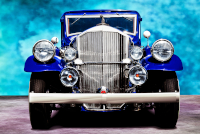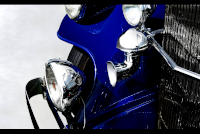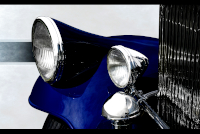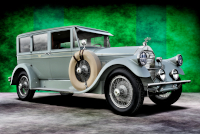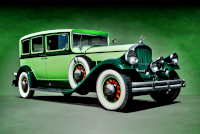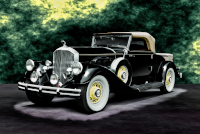Location:
St. Michaels Concours d'Elegance, 2009
Owner: Liz & Don Meyer | Lebanon, New Jersey
Prologue:
With gusto, I jumped into this gallery. In 2009, the old CCD sensor performance hit its peak, a combination of good light conditions at every show we visited and enough concentration on my part to take advantage. I did not shoot enough portraiture that year, (hardly any), but I scrutinized each composition. The results should be evident here, a set in which I wanted to focus on this Pierce-Arrow's chrome clatter across the fascia. High contrast is no problem, all the better to push the saturation. And all of the cut lines are proper, I think. So I'm proud of this set many years on, and happy to finally give these shots adequate service.
- - - - - - - - - -
► Image Source: Nikon D200 (10.2 MP) | Images 5 and 6 elongated for better effect, finished at 10.8 MP.
References:
- Ralston, Marc. "Pierce-Arrow" A.S. Barnes & Co., Inc., San Diego, CA. 1980, page 151-153, 232
- Automobile Quarterly, Volume 6, Number 3, Third Quarter 1968, "Pierce-Arrow: An American Aristocrat" by Maurice D. Hendry, The Kutztown Publishing Company, Inc., Kutztown, PA, page 259
- Automobile Quarterly, Volume 28, Number 4, Fourth Quarter 1990, "The Last Years of Luxury" by John C. Meyer III, The Kutztown Publishing Company, Inc., Kutztown, PA, page 89, 95
- Bonhams: See the 2013 auction listing for #2050009, but note the motor displacement and power figure does not match the Model 53 specification (or the larger V-12 specification for that matter).
1932 is the debut year for Pierce-Arrow's V-12, hardly a panacea for the company's financial trouble, no different than any other luxury manufacturer in the Depression era. But the Pierce-Arrow V-12 is a begrudgingly well developed unit first produced in 398 and 429 cubic inch displacement. The Model 53 uses the former, a marginally larger motor than the 366 cubic inch straight 8-cylinder, with no meaningful advantage other than smoothness of operation and a slight improvement in low-end torque. So 1932 becomes the only year for the smallest Pierce-Arrow V-12, whereas the 429 will carry on, joined by the record-breaking 462 cubic inch unit the following year.
Well known to the Pierce-Arrow Society, this particular sedan appears frequently in online material, a very eye-catching composition in cobalt and silver. The Model 53 uses a slightly shorter wheelbase than its predecessors, though lacks nothing in presence. Bonhams notes that chassis #2050009 is the ninth Model 53 built, (though misrepresents the displacement), a very early car in the 1932 production run, and therefore a very early example of the Karl Wise V-12. Its place in the Pierce-Arrow portfolio represents the continuity of sedans, now firmly installed at the head of market popularity.
A Late Player, Pierce-Arrow Join the Multicylinder Race with the Last of Studebaker's Cash
Note that Pierce-Arrow needed four years to progress from the last of its luxury sixes, the 1928 Model 36, to the first of its modernized, multi-cylinder cars here in the Model 53. Cadillac had already debuted its V-16 at the very beginning of 1930, and Marmon its V-16 in 1931. And of course Packard were long purveyors of the V-12, having already retired and then revived its twin-six. So Pierce-Arrow's interstitial step up to a straight 8-cylinder in 1929 was somewhat inconsequential, whatever the intrinsic quality of a Pierce-Arrow and its mechanical componentry. To then enter the multi-cylinder race late, without much performance gain, recovers little ground in a crowded market.
By the numbers, the company had spent $2 million of Studebaker's cash in factory upgrades and new tooling between 1930 and 1932. For the 1932 sales year, Pierce-Arrow raised the cost of all models by about $500, which Ralston suggests perhaps stymied sales. Sales dropped 25%. The company brought in $8 million in revenue, but lost $3 million overall.
Much will change in 1933 with fresh bankruptcy and Studebaker's quick departure, and all for the better as Pierce-Arrow demonstrate their typical world-crushing will to compete. But these transition years from 1929 to 1932 are not lost years. Neither are they fatal despite economic conditions. Rather that Studebaker stepped in and saved Pierce-Arrow at its own peril, allowing the marque to recover ground lost to competition out of long-standing conservatism.
Motor: 6,522 cc (398 cubic inches) 80° V-12, cast-iron block | 88.9 mm x 101.6 mm (3½" x 4")
The Model 53 uses the lesser of two debut V-12 motors. Already behind in the cylinder race by the time of 1929's bump to an 8-cylinder plant, the V-12 is largely a response to the Cadillac V-16 of 1930, which merely exacerbated the technology gap. Karl M. Wise designed the basic plan, produced in 398 and 429 cubic inch displacement. Compared to their own 366 cubic inch 8-cylinder, Pierce-Arrow realized not so much an advantage in power and performance from the smaller of the V-12 motors, but a natural improvement in smoothness. That said, 1932 is the only year of the 398 V-12, "the greater friction of the twelve counter[acting] the slightly greater displacement," say Automobile Quarterly. Ergo, no practical gain.
As to power delivery, the V-configuration of course helps, (easier to balance than a long-block straight 8-cylinder), but the Pierce-Arrow unit also provides over 36% greater main bearing surface than Cadillac's V-12. (Greater still than Packard's V-12.) Separate intake manifolds, carburetors, and ignition serve each bank. Clever, the centrally positioned water pump distributes water evenly through the block, and the oil cooler not only balances oil and water temperatures, but also warms the water during cold starts. These are well designed motors built for durability and torque, in keeping with Pierce-Arrow's quality ethos.
Valvetrain: L-head, 2 valves per cylinder
Aspiration: twin single-barrel Stromberg carburetors
Power: 140 hp @ 3,200 rpm
Some sources speculate on higher output, though the claims may simply pull a figure without regard for the specific V-12 and model year in question.
Drivetrain: 3-speed synchromesh manual transmission, rear-wheel drive
Front Suspension: semi-elliptic leaf springs with ride-control shock absorbers
Rear Suspension: live axle with three-quarter-elliptic leaf spings with ride-control shock absorbers
Architecture: steel chassis, steel body panels on wood frame
Wheelbase: 3,479.8 mm (137 inches)
Etymology:
In 1931, Pierce-Arrow replace its one-year-only A-B-C nomenclature with a numerical system ascending backward from 43 to 42 to 41. All three models are straight 8-cylinder cars. In 1932, Pierce-Arrow advance the tens place and, well, they don't so much add a fourth model as reserve a place for an updated 8-cylinder among a line-up of new V-12 cars. The 8-cylinder, they know, performs just as well with greater simplicity than the V-12, albeit without the smooth character of the vee configuration. So, 1932 models begin with the 8-cylinder Model 54, progressing to the 398 cubic inch V-12 Model 53, and onward to the Model 52 and Model 51, both powered by the 429 cubic inch V-12 and differing firstly in the 147-inch wheelbase of the top-end Model 51. So this progression is wholly backward and somewhat cryptic.
To explain (perhaps) the jump from the Model C to the Model 43, we need to look back about a decade. Pierce-Arrow had developed models in a series of 30-something designations since the 1919 Model 31, ending with the 1928 Model 36. After a one-year interlude of wheelbase-based designations in 1929, followed by a one-year experiment with plain and soulless letters in 1930, the decision to instate a 40-something nomenclature probably hearkens back to that Model 36, the forties being the next sequence in a new decade. The '43' signifies the least of three new models for 1931, just as the Model 54 of 1932, with the numbers descending against the cost and prestige of the model. But 1932 is the final year for Pierce-Arrow's confusing Depression-era shuffling. In 1933, the nomenclature will change to a cylinder-based numerical system that will persist until the company's demise in 1938, (though not without continued idiosyncracies).
Value:
Chassis #2050009 sold for $95,450 at Bonhams Scottsdale auction in 2013, after selling for $137,500 three years earlier at RM's Amelia Island auction. Both figures fall shy of the reported $149,000 restoration cost, which is all the more readily apparent in the sparkle and shine of this early Pierce-Arrow V-12.
Modern Assets: A Popular Two-Tone Pierce-Arrow Sedan
Few sedans seem quite so pleasing. The cobalt and silver livery captures the gleam of chrome while enunciating the curves through each compartment window. The body uses a multi-clad binding around the shoulders and hood similar to the Model B, and comparable to industry trends. This style is very similar to Packard, both of which display substantial LeBaron influence, though Pierce-Arrow actually manages a leaner perspective. Of all attributes, the Dawley-designed integrated headlamp, first available in 1914 (a mere 18 years prior), looks positively fresh on these early classic era cars. Tough to believe that the Dawley headlamp remained virtually unchanged for so long, and that a fly-away experiment to improve nocturnal visibility would become a valuable design asset just when Pierce-Arrow were so far behind the times.
Short Wheelbase: Arbitrary Wheelbase Length in Sequential Pierce-Arrow Model Years
The Model 53, like the Model 43 of 1931, is two inches shorter than the 1930 Model B, which is apropos of nothing. The stature of most 1932 Pierce-Arrow cars differs little regardless of the wheelbase, and it is interesting to see how wheelbase length varies (or doesn't) among two and four-door styles. Length does not always indicate passenger accomodation as all luxury cars tend to use a standard wheelbase of minimally grand proportion. In retrospect, a few exercises of the 1931 Model 41 and 42 do evoke a grand character in the spirit of Pierce-Arrow's prestige days, but these are rare among the family. In the main, Pierce-Arrow models from these transitional Studebaker years are conceived to counter prevailing market trends, as opposed to furthering the marque's formative world-beater attitude. But that too will change in 1933.
Lights, Aziz: Visual Attention to a Classic Era Light Complement
For obvious reason, I want to focus on the light arrangement. A fair number of 1932 Pierce-Arrow cars mount a bar with dual auxiliary running lights and dual horns across the grille. Chassis #2050009 adds a pair of Trippe Speedlights to the lower inside fender bouts. Note also the staggered height of the mirrors mounted to each enclosed spare, which seems particular to this car, though perhaps not unique. In sum, classic era luxury often translates to attachment and ornament, both of which appear in surplus on this Model 53 Touring Sedan.
Steel Buds: Pierce-Arrow Classic Artillery Wheels
A concession to those vestigial elements Pierce-Arrow cannot let go, the factory offered two options in place of standard wooden artillery wheels—modern wire wheels, or these steel Budd artillery wheels. The painted steel version allows Pierce-Arrow to have their cake and eat it too, clinging to antique sentiments but updating the manufacture and finish to meet modern sensibilities. On chassis #2050009, the effect is pleasant, offering paint and pinstripes that augment the two-tone livery. The blue on the wheels and rims appears to be darker than the body.
Last Updated: Mar 26, 2025

